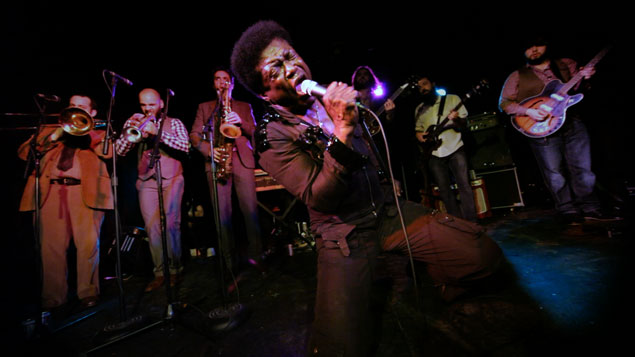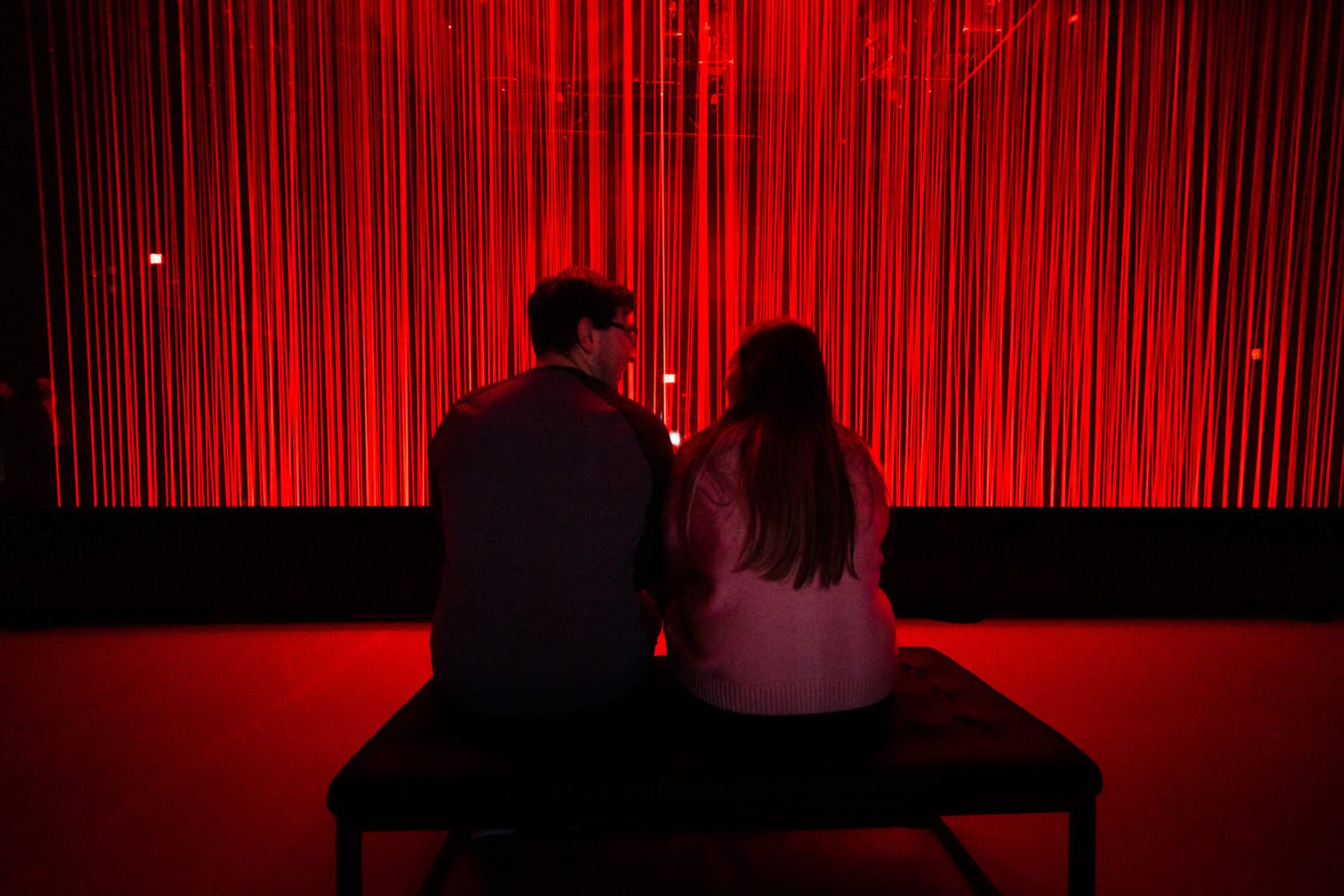Playing Thursday, June 21, at 10:45 PM, and Saturday, June 23, at 10 PM
Few punk bands have come to define the hardcore punk
and post-punk scene in DC more than the exploding supernova of a sound
that was Bad Brains. The group was born when four jazz-trained
musicians who were spending most of their time in bands doing
Earth, Wind, and Fire and Parliament Funkadelic covers suddenly
discovered the Sex Pistols and the Dead Boys, and figured
they could do the same thing as those bands but faster and
louder, and with intimidating precision and control.
Directors
Ben Logan and
Mandy Stein’s
Bad Brains: A Band in DC manages to get access to a treasure trove of archival footage from those early days, and does well to use as much of it as
possible.
Henry Rollins, who saw the band as a teen long before becoming an icon with the likes of Black Flag and his own band, says of his first
Bad Brains show, “That was kind of the start of my life.” Other testimonials, from the likes of
Ian MacKaye,
Dave Grohl, and the Beastie Boys (I’ll admit to getting a little misty seeing
Adam Yauch on film so soon after his untimely
death), match that intensity. And even if the archival footage can’t
necessarily replicate
the powerful experience of being at those shows, the
frightening intensity of the band still shines through, despite the
filter
of years and video of iffy quality. Bad Brains play so fast it
seems impossible that human musicians could stay together at
that speed, and have a hell of a frontman in lead singer
H.R., who sings like some sort of spastic, shamanistic, demented auctioneer.
The filmmakers juxtapose this early footage and a
gradual chronological history of the band’s entire career with film
about
the band’s 2007 reunion tour, during which the ragged edge of
disaster the band’s music seemed always to be riding started
to apply to their interactions as well, and they weren’t as
able to keep from falling over the side. The film opens with bassist
Darryl Jenifer telling his singer that he never wants to see him again, after a show in Chicago that finds H.R., an enigmatic, hippie-ish
figure in his more recent years, standing with a serene grin and essentially refusing to perform,
The question of what’s going on with H.R., who has
been notoriously inconsistent during the band’s sporadic reunion shows,
is the one area of the film that feels frustratingly
incomplete. Speculation about the state of his mental health has long
been a subject of conversation within the punk community, and
it seems obvious from some of his actions in the film that something
is simply not quite right with the man. But the filmmakers seem
reluctant to delve into this subject in any detail, leaving
his erratic behavior hanging out there as an unanswered,
largely unaddressed question. That leaves
A Band in DC as a vital document of the band’s rise; but when it comes to their later years, the film, like H.R. himself, is a little
messy and frustratingly obscured.
—IAN BUCKWALTER
Charles Bradley: Soul of America
Playing Friday, June 22, at 10:30 PM, and Sunday, June 24, at 9:45 AM
We live in an era in which pop stars can be washed up
at 22 and becoming famous requires equal parts talent and a
reality-TV-ready
persona. In this environment,
Charles Bradley is unusual for two reasons:
First, that at the age of 62, after spending an astonishing 48 years
performing as a James Brown
impersonator, Bradley is finally trying to make it on his own
name. And second, that he’s not looking for millions and mansions;
rather, he just wants to make enough money from his music to
support his mother and move himself out of the projects.
Bradley signs with Daptone Records (the label backing
Sharon Jones and the Dap-Kings), and the film spans the month and a
half leading up to the release of his first album; periodic
notes onscreen count down the days until the release party. Bradley,
who has been performing for nearly half a century, is still
learning to be comfortable presenting himself as himself, sans
James Brown wig and spangly cape. Scenes of his
concerts—beautifully filmed, the camera lingering on the curve of a
trumpet
or a hand clasped around a microphone—are interspersed with
interviews with family and his collaborators at Daptone, plus
anecdotes from Bradley himself. The glimpses we get into his
tragic past—negligent parents, murdered brother, months spent
living on the subway—make the obvious deep joy he takes from
performing, and from life itself, even more remarkable.
The one false note is the way filmmaker
Poull Brien’s chosen to illustrate these anecdotes: through
Unsolved Mysteries-style reenactments using actors, which seems completely unnecessary and serves to take the viewer right out of the film.
Luckily there are only a couple of instances of this, and the rest of the movie is undeniably affecting.
Naturally there’s plenty of music in the film, but
it’s juxtaposed with periods of silence as the camera follows Bradley
frying
fish for lunch, paying the bills for his mother’s house, sewing
sequins onto the cuffs of the jumpsuit he plans to wear to
his album release concert. In contrast to the scenes of fans
gushing post-show or friends congratulating him, it’s jarring;
watching him carry his own bags to the car or pass out flyers
for his show, it’s hard not to wonder where he’ll be if his
album doesn’t sell well, how fast the praise showered on him by
the Daptone bigwigs will evaporate if the dollars fail to
materialize.
The film’s title is apt: Charles Bradley is not just a
soul singer in America, he’s a representation of both the opportunity
and the cruelty inherent in American culture. Is it still
possible for this man, who reads at a kindergarten level and sometimes
has to flee his apartment to seek refuge in his mother’s
basement, to pull himself up by his bootstraps and achieve success
the old-fashioned way, no tricks or gimmicks or connections? Is
it possible for dreams to come true?
The most powerful moment comes about three-fourths of
the way through the film. Bradley, in his apartment, speaks directly
to the camera, which zooms in tightly on his creased face. When
asked what he has left to give, he says honestly, breaking
down into tears, that sometimes he wishes for death, that every
day is a struggle and he has to fight as hard as he can to
maintain his honesty and decency. And even though people may
see it as a weakness, he says, if he had all the money in the
world, he wouldn’t let it change who he is. The scene fades
directly into a performance of a song about why it’s so hard to
make it in America. As Bradley sings, eyes closed, pouring his
whole being into the song, you find yourself questioning right
along with him.
—TANYA PAI
Playing Friday, June 22, at 10:45 PM and Saturday, June 23, at 9:30 PM
There’s a scene in
Woody Allen’s
Annie Hall that find’s Allen’s Alvy Singer dining
outdoors at a Sunset Strip restaurant, trying to find something to
satisfy his Manhattan
deli tastes at an organic vegetarian restaurant that seems to
have some variation of sprouts in every item on the menu. That
restaurant was a real one, and it popped up in a number of ’70s
movies, as well as becoming a regular hangout for many LA
celebrities. The eatery, called the Source, also happened to be
the home base for what one social historian in
Maria Demopoulos and
Jodi Wille’s documentary of the same name describes as the archetype for the ’70s Southern California cult.
The film is a meticulously detailed look at the inner workings of the Source Family, a sizeable commune that was gathered
and overseen by the charismatic figure of
Jim Baker, also known as Father Yod (and by
the end of his days, as Father YaHoWha). The film begins with Baker’s
own background, detailing
his youth as a World War II vet and a martial artist, his
eventual turn to criminal activity, and his discovery of Eastern
spirituality. By the time of his death, he was an intense
figure with a mane of gray hair and a huge beard, as close to the
Western artistic representation of the Christian God as one can
imagine.
Cults are normally secretive groups, so what’s so
astounding about watching Demopoulos and Wille’s film is just how much
archival
footage they’re able to use. One member of the group, Isis (in a
standard cult move that aims to separate members from their
pasts, all commune inductees were given new names), became the
group’s historian, and even after they disbanded, she continued
to keep the massive archive of film and photographs intact;
it’s this material that forms the backbone of
The Source.
The other factor working in the film’s favor is just
how many former members of the family the filmmakers are able to get
on camera for interviews, and the diversity of the group both
in their current lives and their feelings towards their time
as members of the family. Some have fully assimilated back into
what one might consider “normal” life, working standard jobs,
running businesses, many of them not necessarily regretful of
their time in the family, but many also saying they wouldn’t
do it again if they had it to do over. Others still live much
as they did back then, largely off the grid and self-sufficient,
living off the land.
The filmmakers give equal voice to all of these
perspectives without ever pulling any punches when it comes to putting
on
display the group’s creepier and more dangerous practices, like
marrying off underage girls who joined the group so that their
parents couldn’t reclaim them, or refusing medical attention
for sick children, or Baker’s eventual decision to allow polygamy
within the group, largely so that he himself might keep 13
wives. That diversity of perspective and honesty in presentation
makes
The Source one of the most detailed looks at the inner workings of an American cult ever assembled, and essential viewing for anyone
fascinated with the psychology and sociology of these groups.
—IAN BUCKWALTER

















